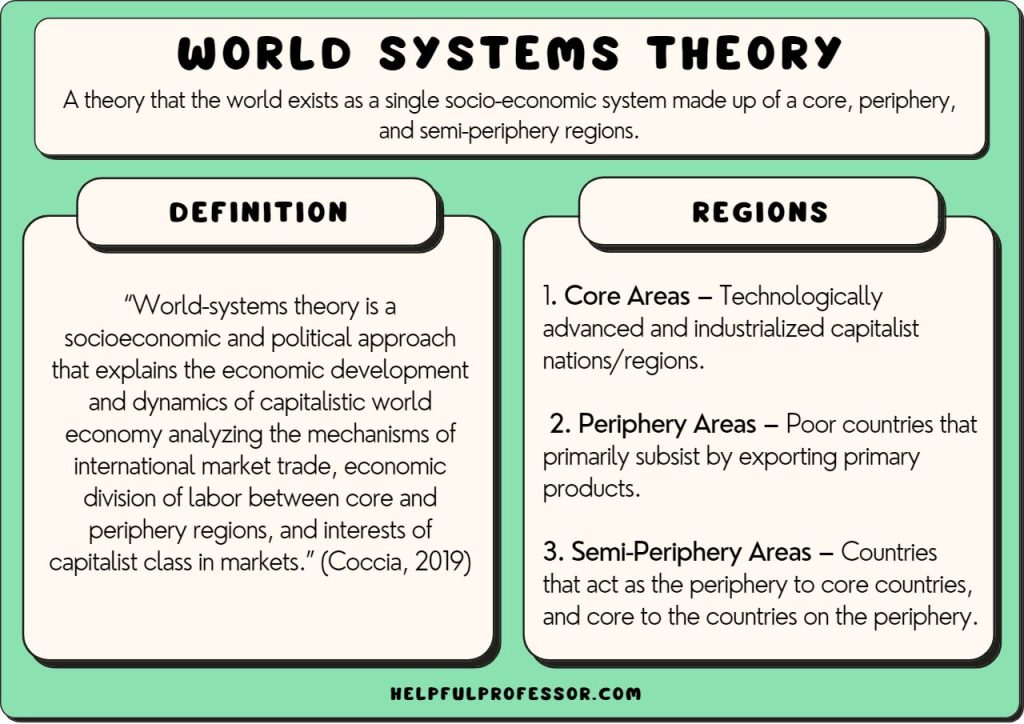Wallerstein’s world capitalist system: A theoretical and historical critique
III.Variants/Critiques
A. Theda Skocpol. ‘Wallerstein’s world capitalist system: A theoretical and historical
critique’. American Journal of Sociology. Vol 82, No 5 (March 1977). Pp. 1075-89
B. ‘Debates’ on the scale and time-depth of capitalist world system
• Andre Gunder Frank. ‘Immanuel and me with-out hyphen.’ Journal of World Systems
Research. Vol. 6, No 2 (Summer/Fall 2000). Pp. 216-231.
• Barry Gills. ‘The continuity thesis on world development.’ In Sing C Chew and
Robert A. Denemark (eds.), The Development of Underdevelopment. Pp. 226-45
• Christopher Chase-Dunn. ‘World-systems: Similarities and differences.’ In Sing C
Chew and Robert A Denemark (eds.). The Development of Underdevelopment. Pp.
246-58
• Optional reading. Andre Gunder Frank. The Five Thousand Year World System.
Humboldt Journal of Social Relations. Vol. 18, No 2. Pp. 1-41
C. World-systems and dependency theories
• James Petras. ‘Dependency and world-system theory: A critiques and new directions.’
Latin American Perspectives. Vol 8, No 3⁄4. (Late Summer/Autumn). Pp. 148-155
The **variants and critiques** of the World-System Perspective reveal the richness of the theoretical debates surrounding Immanuel Wallerstein’s framework. These critiques offer alternative perspectives, point out limitations in Wallerstein’s theory, and expand on or challenge key assumptions about the nature and historical scope of the capitalist world-system. Below is a detailed examination of these critiques and alternative formulations:
### A. **Theda Skocpol: "Wallerstein’s World Capitalist System: A Theoretical and Historical Critique"**
- *American Journal of Sociology, Vol. 82, No. 5 (March 1977), Pp. 1075-89*
Theda Skocpol provides one of the most comprehensive early critiques of Wallerstein’s world-system theory, arguing that it overemphasizes the role of the global economy while underplaying the **autonomy of state actors** and **political institutions**. She is a key representative of **state-centered approaches** to understanding historical change, contrasting with Wallerstein’s **economic determinism**.
#### Key Critiques:
1. **State Autonomy**: Skocpol argues that Wallerstein’s theory treats states as mere agents of the world-system, subordinated to economic processes. She contends that states have greater autonomy and can shape their own policies in ways that challenge or circumvent the pressures of the world economy. For example, she points to **revolutions** and **social movements** that arise from domestic conditions, which Wallerstein’s model fails to fully account for.
2. **Historical Specificity**: Skocpol critiques Wallerstein for his reliance on **broad historical generalizations**. She argues that world-system analysis tends to flatten out differences between historical periods, reducing the complexity of social, political, and cultural factors to a simple core-periphery relationship. According to Skocpol, Wallerstein’s model is insufficiently sensitive to the **unique historical trajectories** of different states and societies.
3. **Underestimation of Political Institutions**: Wallerstein’s theory prioritizes economic factors (e.g., trade, production, and capital accumulation) while underestimating the **role of political institutions** and **state power** in shaping historical outcomes. Skocpol suggests that institutions like the military and bureaucracy have their own logic and can shape social change independently of economic factors.
### B. **Debates on the Scale and Time-Depth of the Capitalist World-System**
1. **Andre Gunder Frank: "Immanuel and Me Without Hyphen"**
- *Journal of World Systems Research, Vol. 6, No. 2 (Summer/Fall 2000), Pp. 216-231*
Andre Gunder Frank, a key figure in **dependency theory** and later a proponent of the **"5,000-year world system"** concept, challenges Wallerstein’s insistence that capitalism emerged in the 16th century. He argues that **global economic systems** existed long before the modern world-system.
#### Key Points:
- **Continuity of World Systems**: Frank contends that the world-system should not be seen as a novel development of the 16th century but rather as the continuation of a much older pattern of global economic interaction dating back millennia. He emphasizes **trade networks** in Asia, Africa, and the Middle East, which had significant global influence long before European dominance.
- **De-centering Europe**: Frank critiques Wallerstein’s Eurocentrism, suggesting that Europe’s rise to prominence was more the result of **Asian decline** than European innovation. According to Frank, regions like China, India, and the Middle East had highly developed economies that played a crucial role in the global system long before European expansion.
2. **Barry Gills: "The Continuity Thesis on World Development"**
- *In Chew and Denemark (eds.), The Development of Underdevelopment, Pp. 226-245*
Barry Gills, like Frank, argues for a **continuity thesis**, suggesting that global economic systems have existed for far longer than Wallerstein acknowledges. Gills highlights the **long history of interconnected trade systems**, particularly in Asia, as evidence that world systems have been present for thousands of years.
#### Key Points:
- **Non-European Centric Histories**: Gills emphasizes the importance of looking at **non-European** centers of power, such as China, India, and the Middle East, as primary drivers of early world systems. He suggests that Europe’s rise was a relatively **late development** in the history of global economies.
3. **Christopher Chase-Dunn: "World-Systems: Similarities and Differences"**
- *In Chew and Denemark (eds.), The Development of Underdevelopment, Pp. 246-258*
Chase-Dunn critiques both Wallerstein and Frank by exploring **similarities and differences** between different world-systems across time. He argues for a more nuanced understanding of world-systems, recognizing both **continuities and changes** over long periods.
#### Key Points:
- **Structural Continuity and Transformation**: Chase-Dunn recognizes the existence of earlier world-systems but also highlights that **capitalism** introduced novel features, such as the unique way it organizes labor and capital globally. He maintains that Wallerstein’s focus on the **16th century** is important because capitalism represents a **qualitatively different world-system**.
- **Hybrid Models**: Chase-Dunn suggests that scholars should look for **hybrid models** that combine insights from both Wallerstein and Frank. While earlier global systems did exist, capitalism has distinct dynamics that are worth emphasizing, such as **cyclical crises**, **global polarization**, and the persistence of core-periphery relations.
4. **Andre Gunder Frank: "The Five Thousand Year World System"** (Optional)
- *Humboldt Journal of Social Relations, Vol. 18, No. 2, Pp. 1-41*
Frank elaborates on his thesis that world systems have existed for over 5,000 years, emphasizing the central role of **Asia** in global economic history. This work de-centers Europe entirely and challenges Wallerstein’s view that the **modern capitalist system** is a distinct historical phenomenon.
#### Key Points:
- **Long-Term Historical Patterns**: Frank argues that modern capitalism is not a new or distinct system but a **continuation of long-term global economic patterns** that date back thousands of years. He draws attention to the **Asian-centered trade networks** that existed well before Europe’s rise.
- **Asia as the Core**: Frank suggests that **Asia**, not Europe, was the dominant core of the global economy for much of history, with Europe only becoming significant after 1500.
### C. **World-Systems and Dependency Theories**
1. **James Petras: "Dependency and World-System Theory: A Critique and New Directions"**
- *Latin American Perspectives, Vol. 8, No. 3/4 (Late Summer/Autumn), Pp. 148-155*
James Petras compares **dependency theory** with **world-systems theory** and offers a critique of both, while also suggesting new directions for understanding global inequality. Dependency theory, developed by thinkers like Andre Gunder Frank and Fernando Henrique Cardoso, focuses on the **unequal relationship** between developed and developing countries, where the latter are structurally dependent on the former.
#### Key Points:
- **Core-Periphery Model**: Like world-systems theory, dependency theory uses the **core-periphery** framework to understand global inequality. However, Petras criticizes both theories for being too **deterministic** and for underestimating the capacity of **local agency** and **resistance** in the periphery. He argues that peripheral nations are not entirely powerless in the face of global capitalism.
- **State and Class Relations**: Petras also critiques Wallerstein for downplaying the role of **domestic class relations** within peripheral countries. He argues that dependency theory, by focusing more on internal dynamics, offers a better explanation for why some nations succeed in breaking free from dependency, while others remain trapped.
- **New Directions**: Petras suggests that future research should focus on **local forms of resistance**, state-led development projects, and the **emergence of new powers** from the global South (e.g., China, India) that challenge the traditional core-periphery relationship.
### Conclusion
The variants and critiques of Wallerstein’s world-systems theory demonstrate the **diverse range of scholarly perspectives** on global capitalism and its historical development. Skocpol’s critique highlights the need to account for **state autonomy** and political institutions, while Frank and Gills emphasize the **long-term continuity** of global economic systems and challenge the **Eurocentrism** in Wallerstein’s work. Chase-Dunn offers a more nuanced view, balancing both continuity and change in the history of world-systems, and Petras bridges the gap between **dependency theory** and world-systems analysis by calling for greater attention to **local agency** and **internal dynamics**.
Together, these critiques deepen our understanding of global inequality, the role of states, and the historical development of capitalism, encouraging students to think critically about the **world-system** and its future trajectory.








